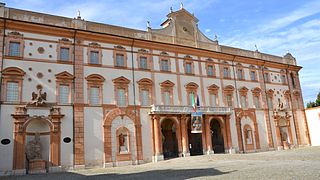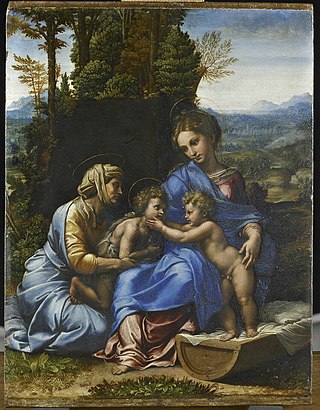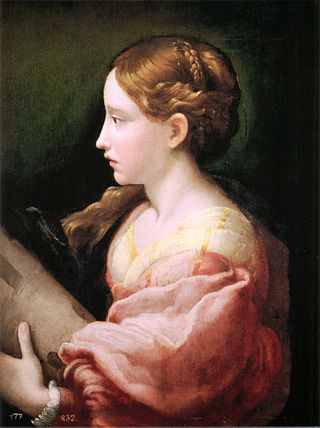

The Perla of Modena (literally, the Pearl of Modena) is an oil on panel painting, dated to 1518-1520 and now attributed to Raphael. It is now in the Galleria Estense in Modena.


The Perla of Modena (literally, the Pearl of Modena) is an oil on panel painting, dated to 1518-1520 and now attributed to Raphael. It is now in the Galleria Estense in Modena.
The painting remained in the Galleria's store-rooms for a long time in a very ornate frame topped by an eagle (the d'Este family crest, also seen on the frames of several works from its collection which are now in the Gemäldegalerie Alte Meister in Dresden). It which drew the curiosity of soprintendente Mario Scalini, who decided to send it to the Florentine restorer Lisa Venerosi Pesciolini and to Art-Test Firenze. The restorer studied and scientifically analysed the work, finding a remarkable quality of painting and under-drawing beneath the surface, including a preparatory drawing which supports the theory that the work is by Raphael himself.
It demonstrated the work to be identical with the head of the Virgin from La Perla (now in the Prado), once thought to be a late work by Raphael but now thought to be by Giulio Romano based on drawings by Raphael, but in 2012 during the exhibition "the last Raphael" (Prado) the experts Paul Joannides and Tom Henry came to the conclusion together with the experts from the Prado and the Louvre where the exhibition later settled. to restore the authorship of the work to Raphael. [1]
The identification of the Modena work was based on the eagle on the frame, on the mention of a "woman's head" by Raphael in a 1663 inventory of the d'Este art collections and on the halo behind the head. It probably formed an initial version of La Perla before being abandoned due to flaws in the panel. The work also allows us to see how 17th century painters in Emilia-Romagna referred to this head and to that of Raphael's Saint Cecelia in their elaboration of classicism.

Annibale Carracci was an Italian painter and instructor, active in Bologna and later in Rome. Along with his brother and cousin, Annibale was one of the progenitors, if not founders of a leading strand of the Baroque style, borrowing from styles from both north and south of their native city, and aspiring for a return to classical monumentality, but adding a more vital dynamism. Painters working under Annibale at the gallery of the Palazzo Farnese would be highly influential in Roman painting for decades.

The Chigi Chapel or Chapel of the Madonna of Loreto is the second chapel on the left-hand side of the nave in the Basilica of Santa Maria del Popolo in Rome. It is the only religious building of Raphael which has been preserved in its near original form. The chapel is a treasure trove of Italian Renaissance and Baroque art and is ranked among the most important monuments in the basilica.

The Transfiguration is the last painting by the Italian High Renaissance master Raphael. Cardinal Giulio de Medici – who later became Pope Clement VII – commissioned the work, conceived as an altarpiece for Narbonne Cathedral in France; Raphael worked on it in the years preceding his death in 1520. The painting exemplifies Raphael's development as an artist and the culmination of his career. Unusually for a depiction of the Transfiguration of Jesus in Christian art, the subject is combined with the next episode from the Gospels in the lower part of the painting. The work is now in the Pinacoteca Vaticana in the Vatican City.

The Self-Portrait with a Friend is a painting by Italian High Renaissance painter Raphael. It dates to 1518–1520, and is in the Louvre Museum of Paris, France. Whether the figure on the left is actually a self-portrait by Raphael is uncertain, although it was already identified as such in a 16th-century print.

The Deposition, also known as the Pala Baglioni, Borghese Entombment or The Entombment, is an oil painting by the Italian High Renaissance painter Raphael. Signed and dated "Raphael. Urbinas. MDVII", the painting is in the Galleria Borghese in Rome. It is the central panel of a larger altarpiece commissioned by Atalanta Baglioni of Perugia in honor of her slain son, Grifonetto Baglioni. Like many works, it shares elements of the common subjects of the Deposition of Christ, the Lamentation of Christ, and the Entombment of Christ. The painting is on wood panel and measures 184 x 176 cm.

Christ Falling on the Way to Calvary, also known as Lo Spasimo or Il Spasimo di Sicilia, is a painting by the Italian High Renaissance painter Raphael, of c. 1514–16, now in the Museo del Prado in Madrid. It is an important work for the development of his style.

The Ducal Palace in Sassuolo is a Baroque villa located in the town of Sassuolo, thirty minutes outside Modena, northern Italy.

The Portrait of Andrea Navagero e Agostino Beazzano is a painting by the Italian High Renaissance painter Raphael, created in 1516. It is housed in the Galleria Doria Pamphilj, Rome.

The Galleria Estense is an art gallery in the heart of Modena, centred around the collection of the d’Este family: rulers of Modena, Reggio and Ferrara from 1289 to 1796. Located on the top floor of the Palazzo dei Musei, on the St. Augustine square, the museum showcases a vast array of works ranging from fresco and oil painting to marble, polychrome and terracotta sculpture; musical instruments; numismatics; curios and decorative antiques.

La Scapigliata is an unfinished painting generally attributed to the Italian High Renaissance artist Leonardo da Vinci, and dated c. 1506–1508. Painted in oil, umber, and white lead pigments on a small poplar wood panel, its attribution remains controversial, with several experts attributing the work to a pupil of Leonardo. The painting has been admired for its captivating beauty, mysterious demeanor, and mastery of sfumato.

La Perla is a 1518-1520 oil on canvas painting by Raphael. At this stage clearly influenced by his encounter with Leonardo (1513-1516) the pyramidal arrangement of the characters, the light contrasts and the recreation of a landscape that is no longer idealized but realistic are proof of it.

Madonna and Child with Saint George is an oil on panel painting by Correggio dating to around 1530 and now in the Gemäldegalerie in Dresden.
The Gallerie Estensi is a network of three museums and a library, bringing together the collective fruits of artistic production from Ferrara, Modena and Sassuolo in the Emilia-Romagna region of Northern Italy. The galleries aim to preserve the historic heritage left by the influential House of Este, with a focus on relating their noble past to the local communities at each site.

The Pinacotecta Nazionale is an art gallery in Ferrara, Emilia-Romagna, Italy. It is located on the piano nobile of the Palazzo dei Diamanti, a work of Renaissance architecture by Biagio Rossetti, commissioned by Leonello d’Este in 1447. Not to be confused with the Civic Museum on the lower floor, which has hosted temporary exhibitions of contemporary art since 1992, the Pinacoteca houses a collection of paintings by the Ferrarese School dating from the thirteenth to the eighteenth centuries. It was founded in 1836 by the Municipality of Ferrara after Napoleon's widespread dissolution of churches threatened the protection of important public artworks. The gallery is formed as much around notable northern Italian painters as it is around the exquisite interior decoration of the palace itself, together with remnants of frescoes from local churches and later acquisitions from the Sacrati Strozzi collection.

The Small Holy Family is an oil-on-panel painting by Raphael and assistants, now in the Louvre in Paris. Its name distinguishes it from his Great Holy Family, also in the Louvre. It is signed and dated "RAPHAEL VRBINAS S[anti] PINGEBAT MDXVIII" on the hem of the Madonna's garment.

Holy Family under an Oak Tree or Madonna of the Oak Tree is an oil-on-panel painting by the Italian Renaissance artist Giulio Romano using a composition or underdrawing by Raphael. It is now in the Prado in Madrid. It is dated to c. 1518 by its stylistic similarities to other works produced by the two artists around that time such as La Perla (Prado). In the background is a valley reminiscent of that of the River Tiber, with a ruin on a hill to the left based on the Basilica of Maxentius or the Baths of Caracalla.

Saint Barbara is an oil on panel painting by Parmigianino, created c. 1523, now in the Prado Museum in Madrid. Copies of it are in the Mauritshuis, Pomona College and Chatsworth House.

Venus and Cupid is an oil painting on panel of c. 1533 by Pontormo, from a lost drawing or cartoon by Michelangelo, in the Galleria dell'Accademia in Florence. A preparatory study is in the British Museum and a copy by Michele di Ridolfo del Ghirlandaio is in the Palazzo Colonna in Rome. Other copies are in the Royal Collection at Kensington Palace, in Hildesheim, a small version in Geneva attributed to Michele Tosini and two in the Museo di Capodimonte in Naples. Giorgio Vasari made three copies for Ottaviano de' Medici.

The Casalmaggiore Altarpiece is a 1540 oil on panel painting by Parmigianino, now in the Gemäldegalerie in Dresden, which acquired it from the Este collection in 1746.